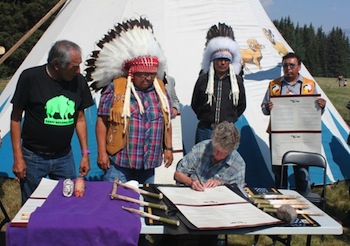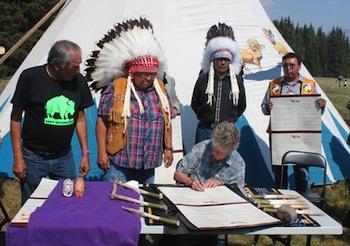Image Caption
By Shari Narine
Sweetgrass Contributing Editor
BANFF
September 28, 2016.
The Northern Tribes Buffalo Treaty is one of the highlights in 10 years of bison conservation.
The American Bison Society is meeting in Banff over three days for its annual meeting. This year marks 10 years since the ABS resumed its operations.
The treaty was signed in 2014 by the Piikani, Siksika and Tsuut’ina First Nations and Blood Tribe with four tribes in Montana, committing to the conservation, culture, and education, among other points, of buffalo. Since the initial signing, the Stoney Nakoda, Samson Cree and 10 Saskatchewan First Nations have joined.
The treaty was followed up earlier this spring with the transfer of 87 plains buffalo from Elk Island National Park to the Blackfeet Nation.
“In essence, the Elk Island project is a step in that strategic process to get buffalo back home to these people who have a long standing cultural, spiritual connection to bison…. We’re linking culture and conservation. We see them as inseparable,” said Keith Aune, director of bison program for North America, with the Wildlife Conservation Society and the American Bison Society.
The ABS conference is highly focused on the Indigenous connection to buffalo. Sessions included “Surveying values, needs and aspirations of tribal communities for the return of buffalo to Indian Country,” “Integrating culture into bison restoration,” and “Bison ecological restoration: examining different cultural and stakeholder perspectives.”
Panelists and speakers included Blood Tribe Elders Paulette Fox and Dr. Leroy Little Bear, and Piikani Nation Councillor Lowell C. Yellowhorn.
Little Bear was instrumental in the Northern Tribes Buffalo Treaty.
“I think it’s kind of a like a rebirth of the old Indian way of doing things,” he told Sweetgrass shortly after the treaty was signed. “Our people are coming together to find a common cause to work on.”
Little Bear, who serves as a professor emeritus of Native American studies at the University of Lethbridge, says Elders began the Inni (Blackfoot for buffalo) Initiative in 2009, recognizing the need for cultural revival.
“We know the buffalo is not the only aspect of culture but it’s a very important part of culture. It is used in religion and sacred societies. Stories revolve around the buffalo,” he said. “If we were able to bring the buffalo back into our midst, if the kids were able to see the buffalo on a regular basis, that part of our culture would come back to life.”
The conference concludes Thursday with new signatories to the Buffalo Treaty.

Joining the initial eight signatories of the Northern Tribes Buffalo Treaty in 2015 were (from left) Leroy Little Bear of the Blood Tribe, Wesley Band Nakoda Chief Ernest Wesley, WCS Vice President, Species Conservation Elizabeth Bennett (signing as witness to treaty), Chief Kurt Buffalo from the Samson Cree Tribe and Narvil Kootenay from the Bearspaw band of the Stoney Nakoda Tribe, (Photo: supplied)

